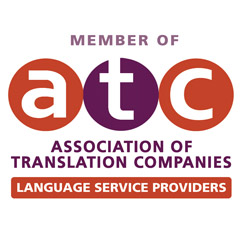Translation is a discipline that requires precision, cultural understanding, and a deep mastery of the languages involved. However, it is common to encounter errors that can compromise the original meaning of the text. This article will address the most frequent translation mistakes and strategies to avoid them.

Common translation mistakes:
Lexical errors
One of the most common translation mistakes is the incorrect use of lexicon. This problem occurs when you translate a word literally without considering its actual meaning in context. For example, the English word “actually” does not mean “actualmente” in Spanish but rather “de hecho” or “en realidad.” To avoid this error, it is essential to analyze the meaning of words in their context and use specialized dictionaries.
False friends
False friends are words that look similar in two languages but have different meanings. A classic example is “embarrassed” in English, which does not mean “embarazada” in Spanish but rather “avergonzado.” Another case is “sensible,” which in English means “sensato” rather than “sensible.” You may check the meaning of words in multiple reliable sources and consider their context of use to avoid this mistake.
Grammatical errors
Grammar varies from one language to another, and some mistakes arise when applying the rules of one language to another. For example, in English, adjectives usually precede the noun, while in Spanish, they generally follow it. A common mistake is translating “a red car” literally as “un rojo coche” instead of “un coche rojo.” To avoid these problems, one must have a solid knowledge of both languages’ grammar and review structures before finalizing the translation.
Linguistic calques
A linguistic calque is an error that occurs when you translate an expression literally without adapting it to the target language. An example is “make a decision,” which should be translated as “tomar una decisión” rather than “hacer una decisión.” Another common case is “have a good time,” which should be translated as “pasarlo bien” instead of “tener un buen tiempo.” To avoid these errors, professionals recommend to consult reference sources and be familiar with idiomatic expressions in both languages.
Agreement errors
Agreement errors occur when there is no consistency in gender, number, or verb tense within a sentence. An example is the incorrect translation of “the big house” as “la grande casa” instead of “la casa grande.” To avoid such errors, it is important to review the grammar and syntax of the target language and make necessary corrections before finalizing the translation.
Loss of original meaning
In some translations, the original meaning of the text is lost due to incorrect interpretation. This can happen when you omit important words or reorganize incorrectly phrases. To avoid this, professionals recommend to read read the original text multiple times before translate and consult native speakers or language experts.
Literal translation
One of the most detrimental translation mistakes is literal translation. While it may work in some cases, in others, it can alter the message’s meaning. For example, the phrase “It’s raining cats and dogs” does not mean “Está lloviendo gatos y perros” but “Está lloviendo a cántaros.” To avoid this mistake, one should look for the idiomatic equivalent in the target language rather than translating word for word.
Lack of cultural adaptation
A fundamental aspect of translation is the cultural adaptation of the message. Some terms, references, or expressions may not have a direct equivalent in another language or may be culturally inappropriate. For example, you may cause confusion if you translate “Thanksgiving” as “Acción de Gracias” in a country where this holiday is not celebrated. In such cases, it is better to explain or adapt the concept so that the reader understands it in context.
Punctuation errors
Each language has its own punctuation rules, and errors in this aspect can alter the text’s meaning. For example, in English, the Oxford comma is commonly used, whereas in Spanish, it is not. There are also differences in the use of colons and question and exclamation marks. To avoid these mistakes, one must know the punctuation rules of both languages and review the text before submission.
Omission or addition of words
Sometimes, words you omit or unnecessarily add in translation, can change the original message’s meaning. For example, you can translate correctly the phrase “He is my friend” as “Él es mi amigo,” but if you omitte the pronoun “él”, the sentence may sound ambiguous in some contexts. To avoid these mistakes, one should review the translation multiple times and compare it with the original text.
Errors in the translation of proper names and titles
You should not always translate proper names and titles literally. Some literary works, movies, or institutions have official translations. For example, “To Kill a Mockingbird” is translated as “Matar a un ruiseñor” rather than “Matar a un pájaro burlón.” Before you translate proper names or titles, it is advisable to research whether an official version exists in the target language.
Incorrect use of prepositions
Prepositions vary by language, and incorrect usage can lead to translation errors. For example, in English, “interested in” is correct, while in Spanish, it is “interesado en,” but a common mistake is translating it as “interesado sobre.” To avoid this problem, you should pay attention to word combinations and consult grammatical references.
Errors in technical and scientific translation
In technical and scientific texts, incorrect use of specific terms can affect content accuracy. An example is the confusion between “data” and “datum” in English, where “data” is plural and “datum” is singular. In Spanish, people normally use “datos” in plural. To avoid mistakes in specialized translations, it is important to use glossaries and reliable reference sources.
Problems in software and website localization
Software and website localization requires not only linguistic but also cultural and functional adaptation. A common mistake is translating menus and buttons without considering the user experience. For example, you can translate “File” in English as “Archivo,” but in some contexts, “Fichero” may be more appropriate. To avoid localization errors, it is advisable to conduct tests with native speakers and evaluate content consistency.
Errors in subtitle and dubbing translation
A common mistake is translating idiomatic expressions literally, resulting in unnatural phrases. For example, “break a leg” does not mean “rómpete una pierna” but “mucha suerte.” To avoid errors in subtitles and dubbing, it is important to adapt the content to the target audience’s cultural and linguistic context.
Challenges in legal translation
The translation of legal documents requires precision and specialized knowledge. A mistake in legal terminology can alter the meaning of a contract or official document. For example, “notary public” in English is not “notario público” in Spanish but “fedatario público” in some countries. To avoid errors in legal translation, professionals recommend that you work with professionals in the field and use specific legal dictionaries.



